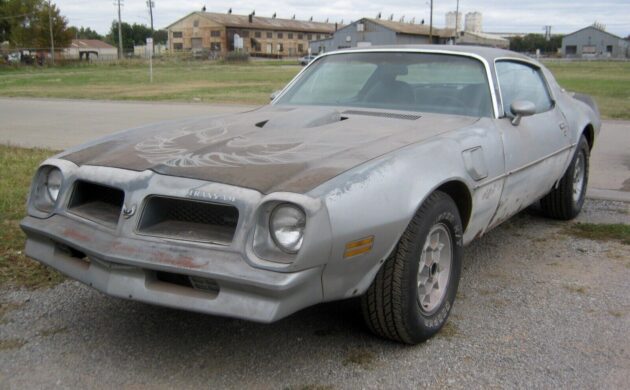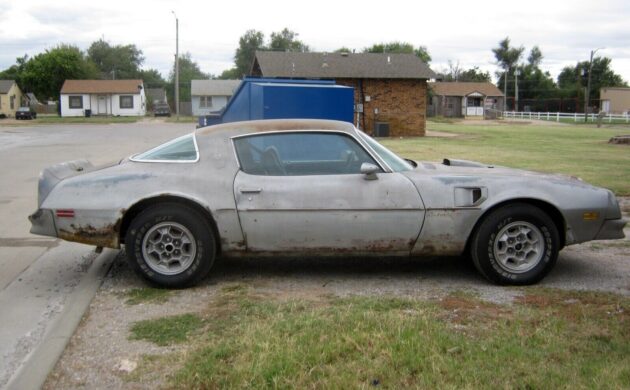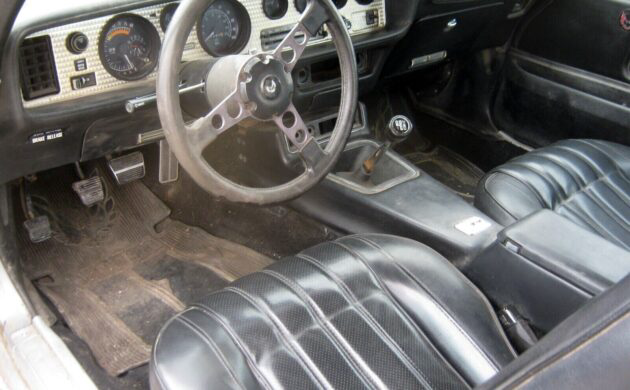Pontiac became the effective performance arm of the General Motors empire when it released the original GTO, and it actively pursued that role almost until the day GM closed its doors. When other marques were coping with tightening emission regulations during the 1970s, Pontiac continued injecting as much excitement into its model range as legislation allowed, which is perfectly encapsulated in this 1976 Pontiac Trans Am. It looks rough and has rust requiring attention, but it retains its original 455ci V8 and four-speed manual transmission. The Trans Am has generated plenty of interest since the seller listed it here on eBay in Enid, Oklahoma. Bidding has raced to $5,100 in a No Reserve auction.
The story of this Trans Am is a common one where a desirable classic spent decades in storage courtesy of a minor mechanical fault. The seller recently purchased the Pontiac from its original owner, who parked it in the 1990s due to clutch failure. It remained hidden until last year, and the initial impression is that the storage environment was less than ideal. The Sterling Silver paint has deteriorated significantly, while the decals have faded to the point where they have virtually disappeared. However, the cosmetic deterioration is the least of this car’s problems because the winning bidder faces many hours of cutting, grinding, and welding to return it to a rust-free state. Many of the lower body extremities have succumbed to the problem, but the story is far better when we climb below the surface. The trunk pan has holes, and there are issues with the front floors, but the rear floors and rails carry nothing beyond heavy surface corrosion. The panel gaps are consistent, and the fact the doors open and close cleanly suggests the car might be structurally sound. The spoilers and scoops should be restored with little effort, and it appears there are no issues with the tinted glass.
Finding any car from the second half of the 1970s with anything resembling performance was a big ask, but Pontiac gave it a shot with the ’76 Trans Am. The range-topping 455ci V8 produced 200hp and 330 ft/lbs of torque, with both figures looking less than impressive by modern standards. This Trans Am retains its numbers-matching drivetrain, with the 455 backed by a four-speed manual transmission. The car would have covered the ¼-mile in 16.4 seconds in its prime, but that was long ago. The original owner parked the Pontiac in the 1990s due to clutch failure, and that problem persists today. The seller coaxed it back to life, and that mighty V8 runs well. The list of mechanical needs extends beyond the clutch, with the seller indicating a carburetor rebuild, an oil pan gasket leak, a brake rebuild, and a noisy u-joint will all be on the buyer’s “to-do” list. Tackling these issues can happen as required because I suspect the winning bidder will initially focus on the panel and paint needs.
The Trans Am’s interior is surprising because it hasn’t deteriorated to the same extent as the exterior. The seatcovers have enough minor defects to suggest that replacement would be wise. The same is true of the carpet, but the spotless dash, pad, door trims, console, and console lid mean that returning the inside of this classic to its former glory won’t break the bank. The seller indicates the air conditioning is intact, with the original owner equipping the Trans Am with power windows, power locks, cruise control, and a tilt wheel. The holes in the dash and console are consistent with this car originally featuring a factory radio and 8-track player. Both items are MIA, but these frequently appear at reasonable prices on the usual online auction sites.
Restoring this 1976 Pontiac Trans Am won’t be for the faint-hearted. It is a significant undertaking that will consume hundreds of hours and thousands of dollars. Has that deterred potential buyers? Not in the least. This Trans Am has received thirty-nine bids, suggesting many view it as a rough diamond that they can bring back from the brink. The No Reserve listing guarantees it will find a new home, but have you seen enough to tempt you to make it yours?






This car was rode hard and put away wet literally with all the rust.Neat car but way too rusty and needs a ton of work and $ thrown at it imo. I think it’s definetly topped out at 5k.This car will cost you a kings ransom to restore.
Wouldn’t be so bad Ifn you can do it all yourself which myself and my brother can. I would have to build some real horsepower into this one only because I will be keeping it. Really miss my 78 and even though this is not a T-top car and has round headlights. It will be a suitable replacement. Really liked my black 78 but this silver looks great on them also. Hoping to win this one. Would like to see it finished and would really like to be the ones to do it.
Send us some photos when it’s completed Davey Boy!
Such a fantastic powertrain 👏 from Pontiac on these. This is definitely a rough n tumbler. 😕 but hope springs eternal, somebody takes it back to full health.
This is a very savable Trans Am with big block and 4 speed. If I were purchasing to keep, would pull the 455 and perform a complete rebuild and beef it up along the build. I would not rule out repainting in black since it has black interior and go bird delete on the hood. Locate the new 17″ honeycomb gold rims, get the S/D 455 shaker hood and you have a nice ride for show and go!
Correction, Pontiac 400 and 455 are both small blocks.
I respectfully disagree with describing the Pontiac V8 engine a small-block. If any known Pontiac authority so describes it, please let us know.
I would suggest that the terms small-block and big-block are specific to those manufacturers who have two distinctly different sized engines. Pontiac only had one basic V8 engine architecture, so there is no second line that is bigger or smaller that would thus lead to being designated as small-blocks and big-blocks. It is just the Pontiac V8. Of course Pontiac did have small journal and large journal engines, and taller and shorter deck height engines, but no big-block or small-block.
In terms of actual mass, most small-blocks are generally considered to weigh 500-600 pounds and most big-blocks are generally considered to weigh 600-700 pounds, though there are exceptions which are lighter(Ford 289/302 in the mid/high 400 lb. range) or heavier(MoPar Street Hemi at well over 700 lbs.). The Pontiac V8s are in the 600s and thus more akin to the big-block engines of other manufacturers, but I would still not call the Pontiac V8 a big-block. Just my 2 cents. :-)
Pontiac V-8’s are neither big nor small blocks. They are all the same block size, just different bore and stroke
Pontiac blocks, from 326 to 455 are considered intermediate blocks, not small or big.
It’s at 6K now. I’m sure that the desirability is high for a 455 manual, but this better be a rare car for anyone to want to restore it.
I have.the same car in much better shape.Some rust underneath and no screaming chicken.It was a unfinished project I worked on with a friend of mine who passed.I will be selling it soon as my circumstances have changed not for 7g. If anyone is interested it’s in South Carolina
All Trans Ams are Black. The rest are mistakes
No T/A’s were black in ’69-75, except the ’74 one at the Chicago autoshow back in the day. Started as a ’73, converted into a ’74 for the show & then later into a ’76 – survives today with a SD motor.